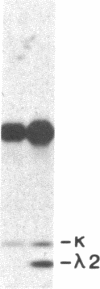Abstract
Antigen-presenting B-lymphoma cells were transfected with the gene encoding the immunoglobulin lambda 2 light chain of MOPC315 cells (lambda 2(315). The lambda 2 chain is expressed on the cell surface of the transfectants together with the endogenous heavy chain. The transfectants present an idiotope of the lambda 2(315) light chain to class II-restricted T-cell clones. Recognition by the T cells requires processing of the lambda 2(315) light chain. From these data we conclude that B-lymphoma cells constitutively process and present their immunoglobulins. Secretion and reuptake of the light chain was not necessary for the presentation. Thus, B cells bear two types of idiotypes on their membrane, a native form as surface immunoglobulin and a processed form in the context of products of the major histocompatibility complex.
Full text
PDF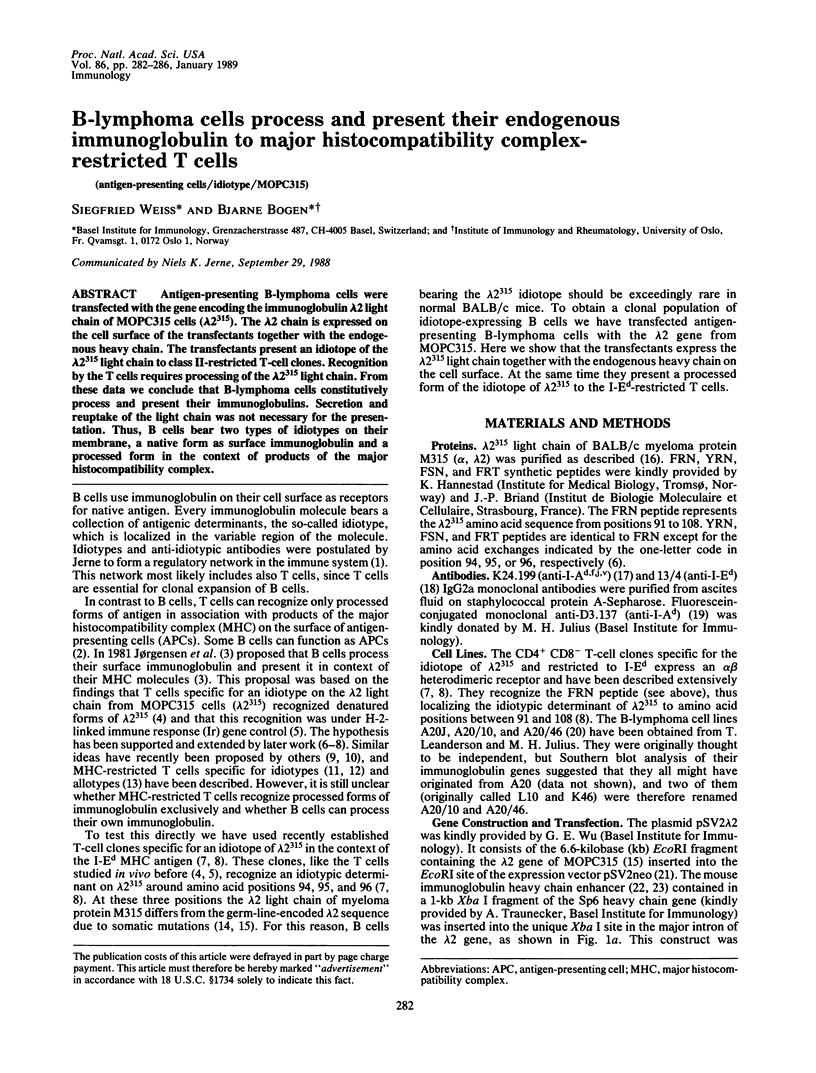
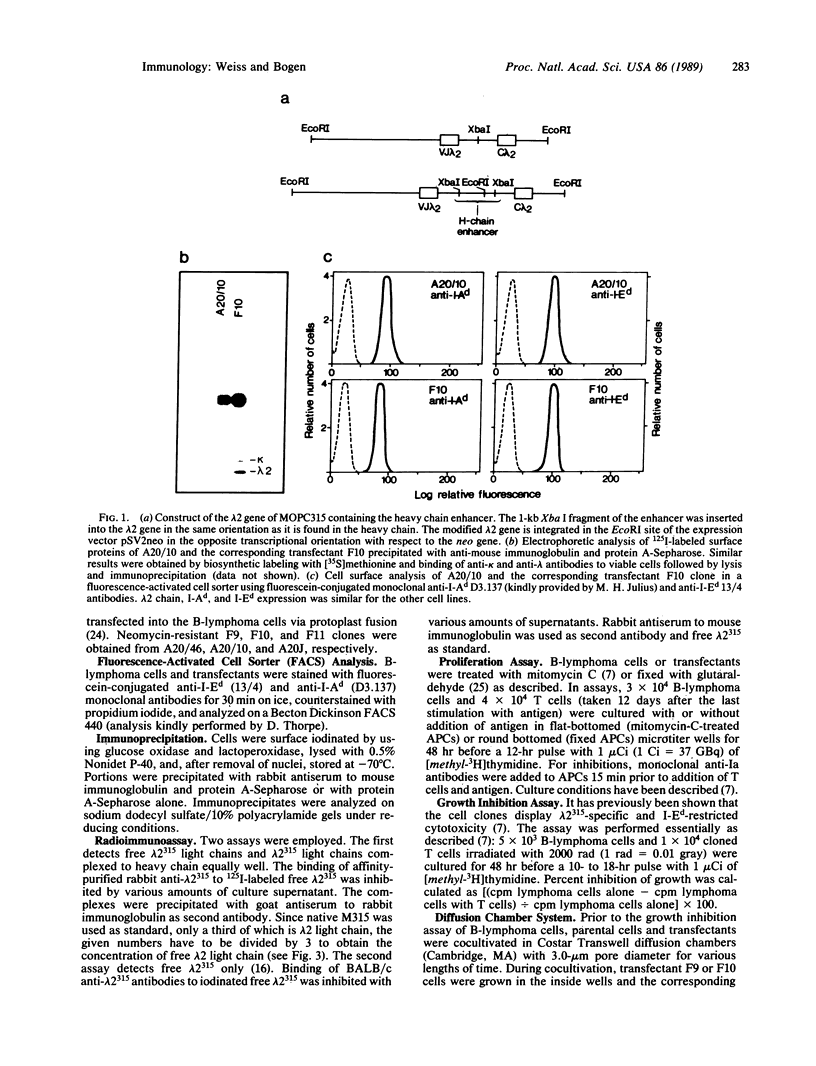
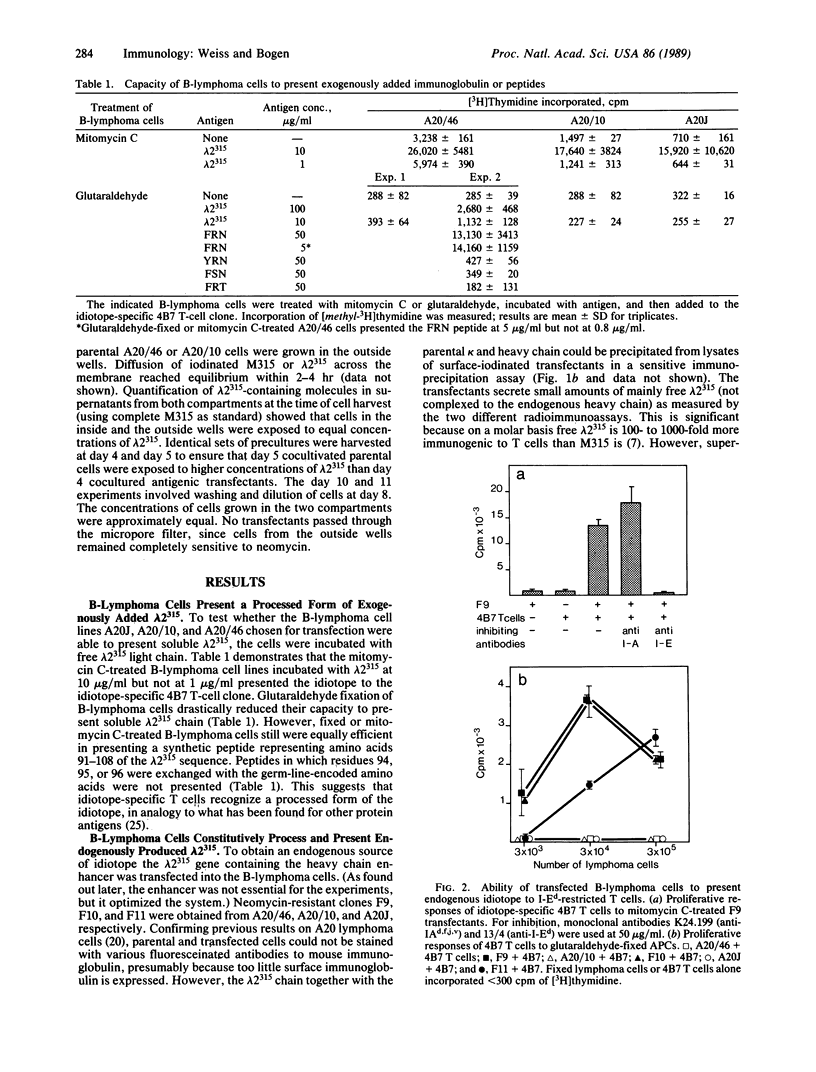
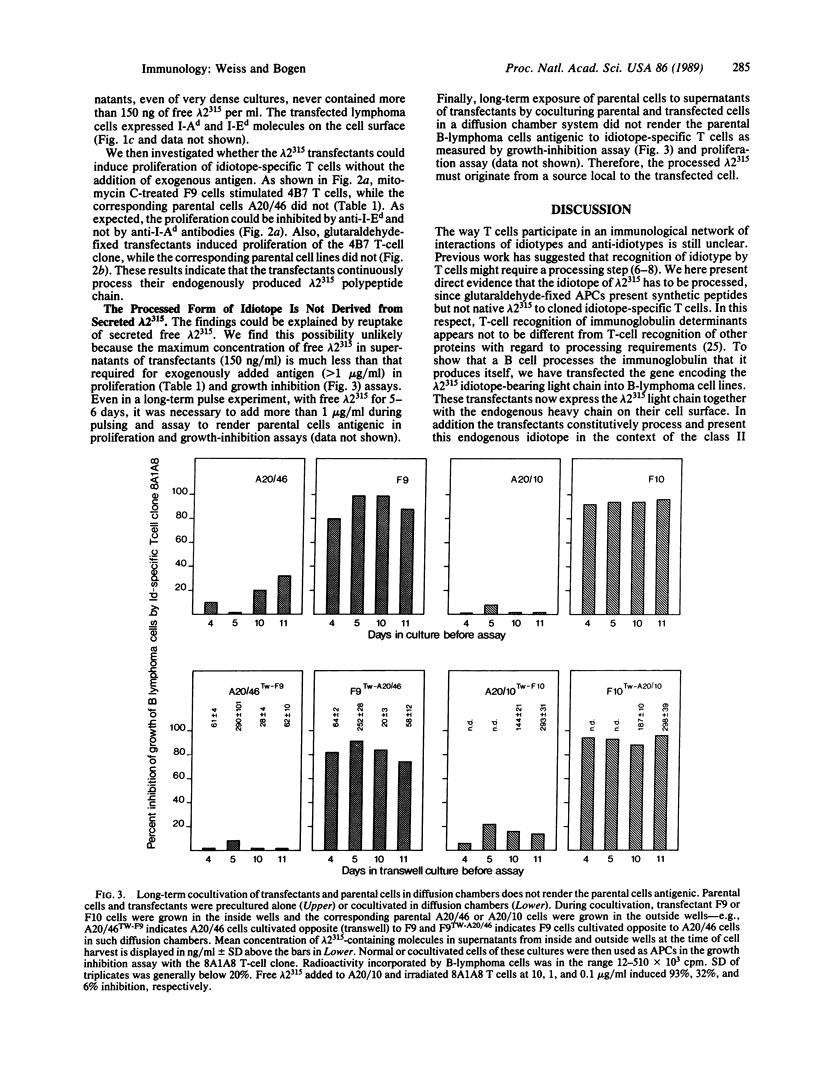
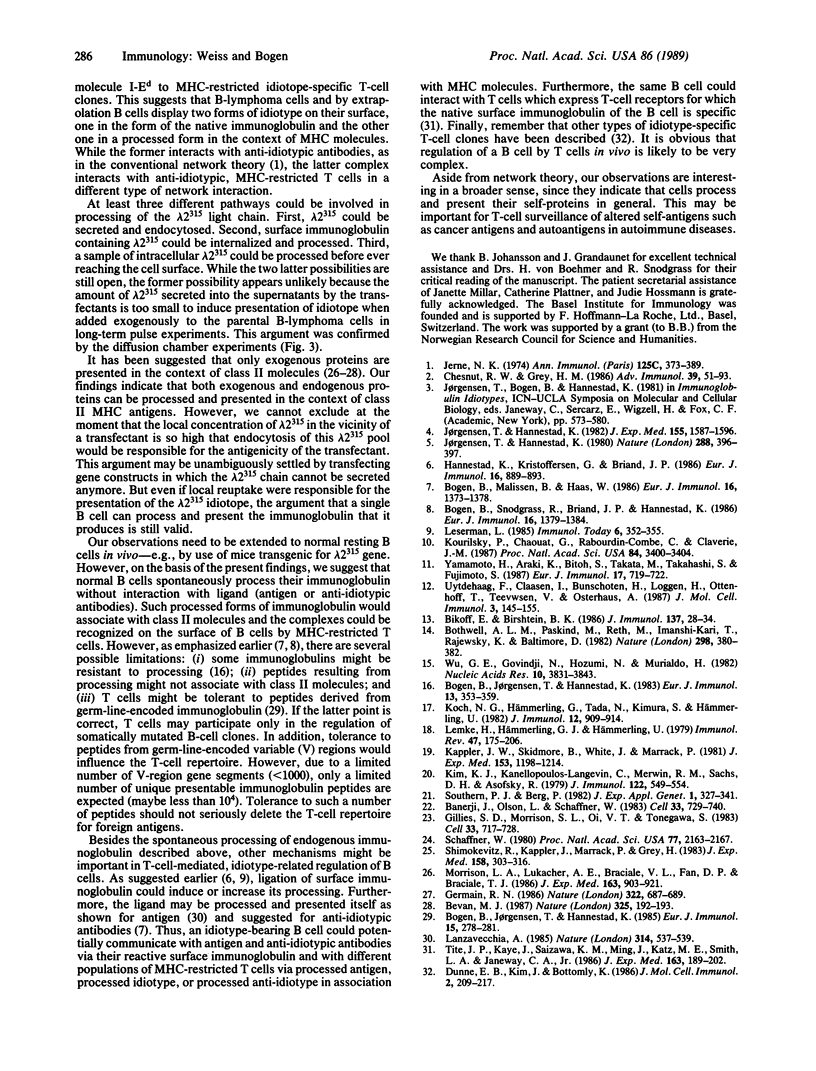
Images in this article
Selected References
These references are in PubMed. This may not be the complete list of references from this article.
- Banerji J., Olson L., Schaffner W. A lymphocyte-specific cellular enhancer is located downstream of the joining region in immunoglobulin heavy chain genes. Cell. 1983 Jul;33(3):729–740. doi: 10.1016/0092-8674(83)90015-6. [DOI] [PubMed] [Google Scholar]
- Bevan M. J. Antigen recognition. Class discrimination in the world of immunology. Nature. 1987 Jan 15;325(6101):192–194. doi: 10.1038/325192b0. [DOI] [PubMed] [Google Scholar]
- Bikoff E., Birshtein B. K. T cell clones specific for IgG2a of the a allotype: direct evidence for presentation of endogenous antigen. J Immunol. 1986 Jul 1;137(1):28–34. [PubMed] [Google Scholar]
- Bogen B., Jørgensen T., Hannestad K. Recognition of lambda 1 and lambda 2 murine light chains by carrier-specific isologous T helper cells; effect of L-H chain assembly. Eur J Immunol. 1983 May;13(5):353–359. doi: 10.1002/eji.1830130502. [DOI] [PubMed] [Google Scholar]
- Bogen B., Jørgensen T., Hannestad K. T helper cell recognition of idiotopes on lambda 2 light chains of M315 and T952: evidence for dependence on somatic mutations in the third hypervariable region. Eur J Immunol. 1985 Mar;15(3):278–281. doi: 10.1002/eji.1830150313. [DOI] [PubMed] [Google Scholar]
- Bogen B., Malissen B., Haas W. Idiotope-specific T cell clones that recognize syngeneic immunoglobulin fragments in the context of class II molecules. Eur J Immunol. 1986 Nov;16(11):1373–1378. doi: 10.1002/eji.1830161110. [DOI] [PubMed] [Google Scholar]
- Bogen B., Snodgrass R., Briand J. P., Hannestad K. Synthetic peptides and beta-chain gene rearrangements reveal a diversified T cell repertoire for a lambda light chain third hypervariable region. Eur J Immunol. 1986 Nov;16(11):1379–1384. doi: 10.1002/eji.1830161111. [DOI] [PubMed] [Google Scholar]
- Bothwell A. L., Paskind M., Reth M., Imanishi-Kari T., Rajewsky K., Baltimore D. Somatic variants of murine immunoglobulin lambda light chains. Nature. 1982 Jul 22;298(5872):380–382. doi: 10.1038/298380a0. [DOI] [PubMed] [Google Scholar]
- Chesnut R. W., Grey H. M. Antigen presentation by B cells and its significance in T-B interactions. Adv Immunol. 1986;39:51–94. doi: 10.1016/s0065-2776(08)60348-x. [DOI] [PubMed] [Google Scholar]
- Dunn E. B., Kim J., Bottomly K. A cloned T cell line that selectively augments antibody responses of phosphorylcholine-specific B cells bearing the T15 idiotype. J Mol Cell Immunol. 1986;2(4):209–217. [PubMed] [Google Scholar]
- Germain R. N. Immunology. The ins and outs of antigen processing and presentation. Nature. 1986 Aug 21;322(6081):687–689. doi: 10.1038/322687a0. [DOI] [PubMed] [Google Scholar]
- Gillies S. D., Morrison S. L., Oi V. T., Tonegawa S. A tissue-specific transcription enhancer element is located in the major intron of a rearranged immunoglobulin heavy chain gene. Cell. 1983 Jul;33(3):717–728. doi: 10.1016/0092-8674(83)90014-4. [DOI] [PubMed] [Google Scholar]
- Hannestad K., Kristoffersen G., Briand J. P. The T lymphocyte response to syngeneic lambda 2 light chain idiotopes. Significance of individual amino acids revealed by variant lambda 2 chains and idiotope-mimicking chemically synthesized peptides. Eur J Immunol. 1986 Aug;16(8):889–893. doi: 10.1002/eji.1830160803. [DOI] [PubMed] [Google Scholar]
- Jerne N. K. Towards a network theory of the immune system. Ann Immunol (Paris) 1974 Jan;125C(1-2):373–389. [PubMed] [Google Scholar]
- Jørgensen T., Hannestad K. Helper T cell recognition of the variable domains of a mouse myeloma protein (315). Effect of the major histocompatibility complex and domain conformation. J Exp Med. 1982 Jun 1;155(6):1587–1596. doi: 10.1084/jem.155.6.1587. [DOI] [PMC free article] [PubMed] [Google Scholar]
- Kappler J. W., Skidmore B., White J., Marrack P. Antigen-inducible, H-2-restricted, interleukin-2-producing T cell hybridomas. Lack of independent antigen and H-2 recognition. J Exp Med. 1981 May 1;153(5):1198–1214. doi: 10.1084/jem.153.5.1198. [DOI] [PMC free article] [PubMed] [Google Scholar]
- Kim K. J., Kanellopoulos-Langevin C., Merwin R. M., Sachs D. H., Asofsky R. Establishment and characterization of BALB/c lymphoma lines with B cell properties. J Immunol. 1979 Feb;122(2):549–554. [PubMed] [Google Scholar]
- Koch N., Hämmerling G. J., Tada N., Kimura S., Hämmerling U. Cross-blocking studies with monoclonal antibodies against I-A molecules of haplotypes b, d and k. Eur J Immunol. 1982 Nov;12(11):909–914. doi: 10.1002/eji.1830121103. [DOI] [PubMed] [Google Scholar]
- Kourilsky P., Chaouat G., Rabourdin-Combe C., Claverie J. M. Working principles in the immune system implied by the "peptidic self" model. Proc Natl Acad Sci U S A. 1987 May;84(10):3400–3404. doi: 10.1073/pnas.84.10.3400. [DOI] [PMC free article] [PubMed] [Google Scholar]
- Lanzavecchia A. Antigen-specific interaction between T and B cells. Nature. 1985 Apr 11;314(6011):537–539. doi: 10.1038/314537a0. [DOI] [PubMed] [Google Scholar]
- Lemke H., Hämmerling G. J., Hämmerling U. Fine specificity analysis with monoclonal antibodies of antigens controlled by the major histocompatibility complex and by the Qa/TL region in mice. Immunol Rev. 1979;47:175–206. doi: 10.1111/j.1600-065x.1979.tb00293.x. [DOI] [PubMed] [Google Scholar]
- Morrison L. A., Lukacher A. E., Braciale V. L., Fan D. P., Braciale T. J. Differences in antigen presentation to MHC class I-and class II-restricted influenza virus-specific cytolytic T lymphocyte clones. J Exp Med. 1986 Apr 1;163(4):903–921. doi: 10.1084/jem.163.4.903. [DOI] [PMC free article] [PubMed] [Google Scholar]
- Schaffner W. Direct transfer of cloned genes from bacteria to mammalian cells. Proc Natl Acad Sci U S A. 1980 Apr;77(4):2163–2167. doi: 10.1073/pnas.77.4.2163. [DOI] [PMC free article] [PubMed] [Google Scholar]
- Shimonkevitz R., Kappler J., Marrack P., Grey H. Antigen recognition by H-2-restricted T cells. I. Cell-free antigen processing. J Exp Med. 1983 Aug 1;158(2):303–316. doi: 10.1084/jem.158.2.303. [DOI] [PMC free article] [PubMed] [Google Scholar]
- Southern P. J., Berg P. Transformation of mammalian cells to antibiotic resistance with a bacterial gene under control of the SV40 early region promoter. J Mol Appl Genet. 1982;1(4):327–341. [PubMed] [Google Scholar]
- Tite J. P., Kaye J., Saizawa K. M., Ming J., Katz M. E., Smith L. A., Janeway C. A., Jr Direct interactions between B and T lymphocytes bearing complementary receptors. J Exp Med. 1986 Jan 1;163(1):189–202. doi: 10.1084/jem.163.1.189. [DOI] [PMC free article] [PubMed] [Google Scholar]
- UytdeHaag F., Claassen I., Bunschoten H., Loggen H., Ottenhoff T., Teeuwsen V., Osterhaus A. Human anti-idiotypic T lymphocyte clones are activated by autologous anti-rabies virus antibodies presented in association with HLA-DQ molecules. J Mol Cell Immunol. 1987;3(3):145–155. [PubMed] [Google Scholar]
- Wu G. E., Govindji N., Hozumi N., Murialdo H. Nucleotide sequence of a chromosomal rearranged lambda 2 immunoglobulin gene of mouse. Nucleic Acids Res. 1982 Jul 10;10(13):3831–3843. doi: 10.1093/nar/10.13.3831. [DOI] [PMC free article] [PubMed] [Google Scholar]
- Yamamoto H., Araki K., Bitoh S., Takata M., Takahashi S., Fujimoto S. Cytotoxic T lymphocyte clone recognizing self idiotype: its regulatory role in antibody production. Eur J Immunol. 1987 May;17(5):719–722. doi: 10.1002/eji.1830170522. [DOI] [PubMed] [Google Scholar]



